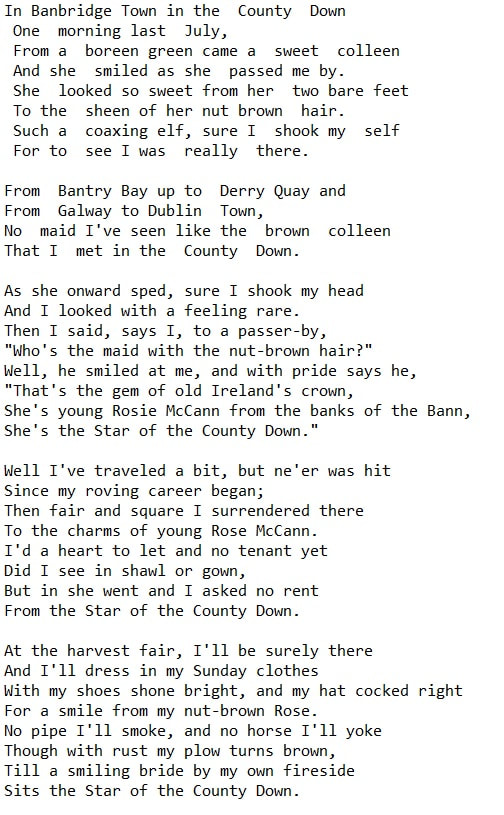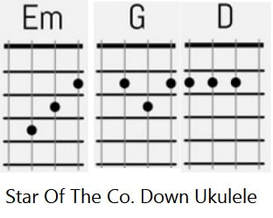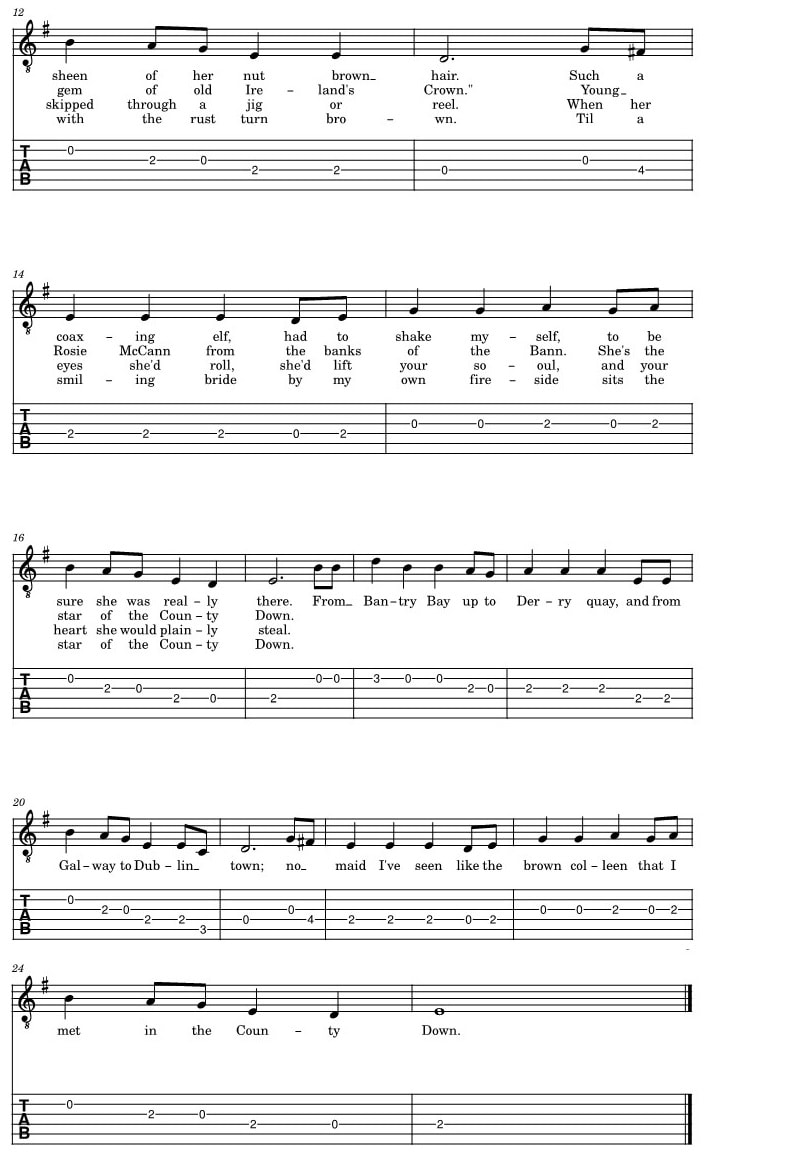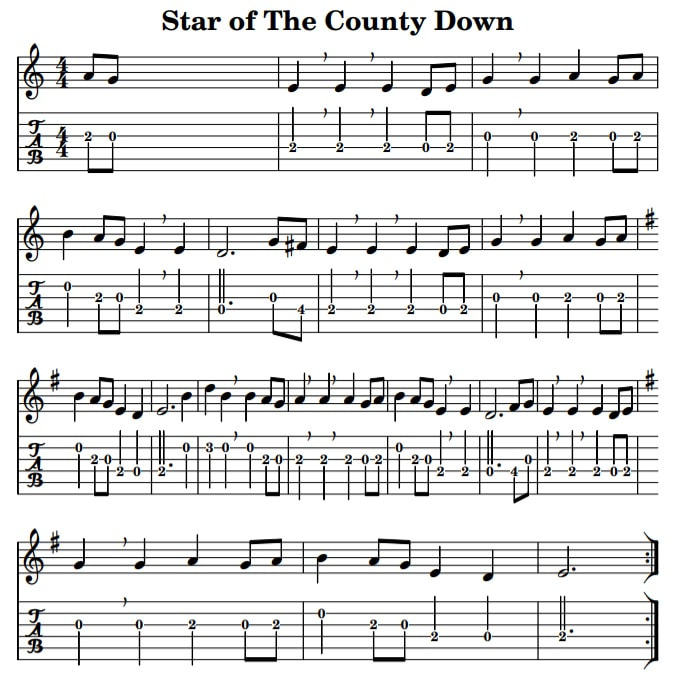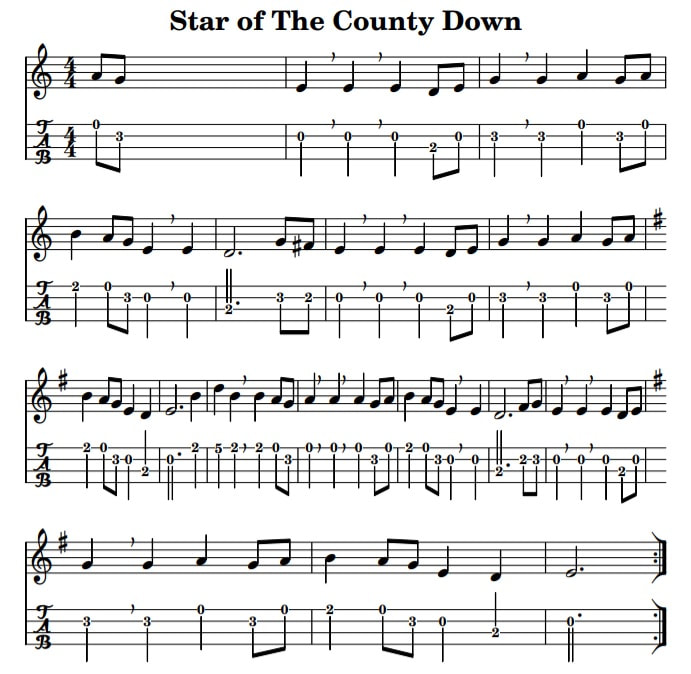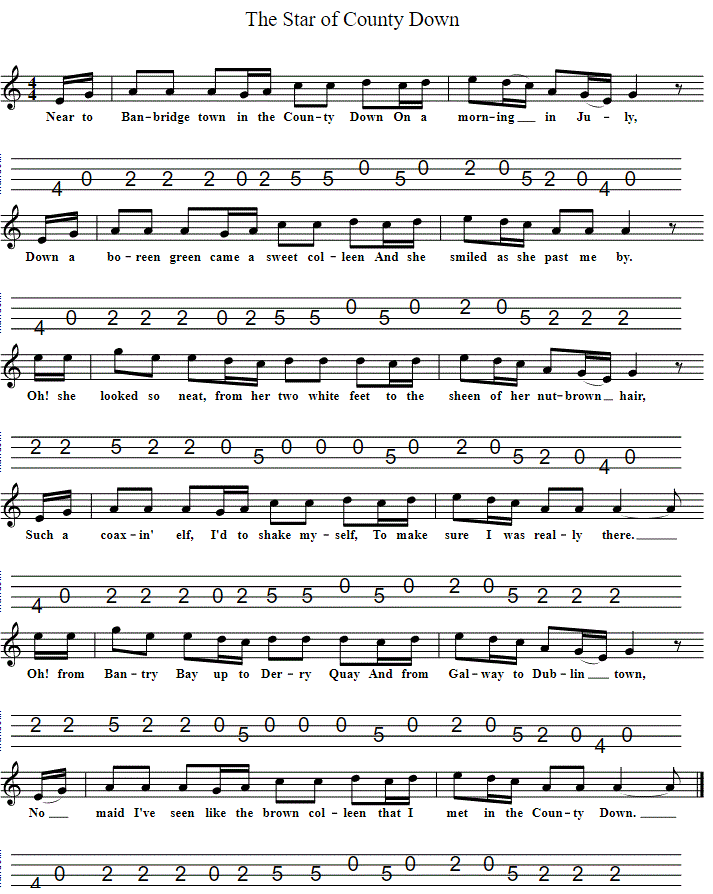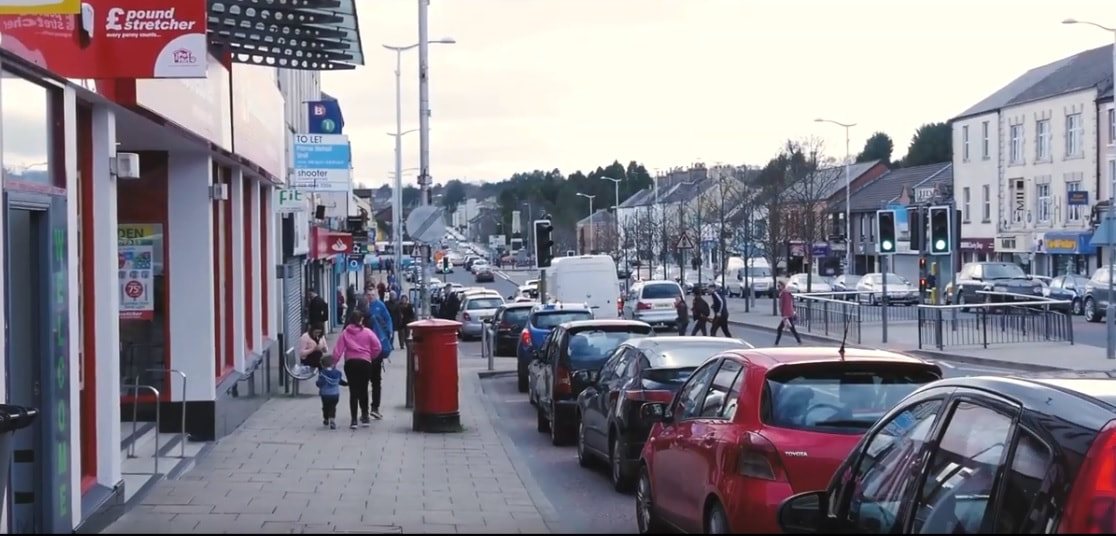The Star Of The County Down Song Lyrics And Guitar Chords
The star of the county down fingerstyle guitar tab included. Written by Cathal McGarvey in 1920. The song is about a young lad infatuated with a girl [Rosie McCann] who he intends to marry if given the chance. Recorded by The Clancy Brothers, The Irish Rovers, Van Morrison, Nathan Carter, Orthodox Celts, The Wolfe Tones The High Kings The Pogues. The youtube video is one of the first ever recordings of the song by John McCormack. Did you know that John McCormack who was the top singer in Ireland from 1920 to 1940s refused to sing any song that was written by Percy French. This was because Percy French was a Protestant and John McCormack was a Catholic, that's how deep feeling were in Ireland at the time. Recently recorded by Angelo Kelly And Family. The Star Of The County Down Sheet Music Notes . The ukulele chords and tab are included. The Tyrone based folk group The Whistlin' Donkeys done a great job recording this song in 2019.The star of the county Down guitar tab added.
[Em] In Banbridge Town in the G County D Down
One Em morning last D July,
From a [Em] boreen green came a [G] sweet [D] colleen
And she [Em] smiled as she [D] passed me by. [Em]
She [G] looked so sweet from her [D] two bare feet
To the [Em] sheen of her nut brown [D] hair.
Such a [Em] coaxing elf, sure I [G] shook my [D] self
For to [Em] see I was [D] really [Em] there.
From [G] Bantry Bay up to [D] Derry Quay and
From [Em] Galway to Dublin [D] Town,
No [Em maid] I've seen like the G brown [D] colleen
That I [Em] met in the D County [Em] Down.
As she onward sped, sure I shook my head
And I looked with a feeling rare.
Then I said, says I, to a passer-by,
"Who's the maid with the nut-brown hair?"
Well, he smiled at me, and with pride says he,
"That's the gem of old Ireland's crown,
She's young Rosie McCann from the banks of the Bann,
She's the Star of the County Down."
Well I've traveled a bit, but ne'er was hit
Since my roving career began;
Then fair and square I surrendered there
To the charms of young Rose McCann.
I'd a heart to let and no tenant yet
Did I see in shawl or gown,
But in she went and I asked no rent
From the Star of the County Down.
At the harvest fair, I'll be surely there
And I'll dress in my Sunday clothes
With my shoes shone bright, and my hat cocked right
For a smile from my nut-brown Rose.
No pipe I'll smoke, and no horse I'll yoke
Though with rust my plow turns brown,
Till a smiling bride by my own fireside
Sits the Star of the County Down.
One Em morning last D July,
From a [Em] boreen green came a [G] sweet [D] colleen
And she [Em] smiled as she [D] passed me by. [Em]
She [G] looked so sweet from her [D] two bare feet
To the [Em] sheen of her nut brown [D] hair.
Such a [Em] coaxing elf, sure I [G] shook my [D] self
For to [Em] see I was [D] really [Em] there.
From [G] Bantry Bay up to [D] Derry Quay and
From [Em] Galway to Dublin [D] Town,
No [Em maid] I've seen like the G brown [D] colleen
That I [Em] met in the D County [Em] Down.
As she onward sped, sure I shook my head
And I looked with a feeling rare.
Then I said, says I, to a passer-by,
"Who's the maid with the nut-brown hair?"
Well, he smiled at me, and with pride says he,
"That's the gem of old Ireland's crown,
She's young Rosie McCann from the banks of the Bann,
She's the Star of the County Down."
Well I've traveled a bit, but ne'er was hit
Since my roving career began;
Then fair and square I surrendered there
To the charms of young Rose McCann.
I'd a heart to let and no tenant yet
Did I see in shawl or gown,
But in she went and I asked no rent
From the Star of the County Down.
At the harvest fair, I'll be surely there
And I'll dress in my Sunday clothes
With my shoes shone bright, and my hat cocked right
For a smile from my nut-brown Rose.
No pipe I'll smoke, and no horse I'll yoke
Though with rust my plow turns brown,
Till a smiling bride by my own fireside
Sits the Star of the County Down.
Here's another version of the chords in the key of Am.
[Am] In Banbridge Town in the G County D Down
One Em morning last D July,
From a [Am] boreen green came a [C] sweet [G] colleen
And she [Am] smiled as she [G] passed me by. [Am]
She [C] looked so sweet from her [G] two bare feet
To the [Am] sheen of her nut brown [G] hair.
Such a [Am] coaxing elf, sure I [C] shook my [G] self
For to [Am] see I was [G] really [Am] there.
From [C] Bantry Bay up to [G] Derry Quay and
From [Am] Galway to Dublin [G] Town,
No [Am maid] I've seen like the G brown [G] colleen
That I [Am] met in the D County [Am] Down.
[Am] In Banbridge Town in the G County D Down
One Em morning last D July,
From a [Am] boreen green came a [C] sweet [G] colleen
And she [Am] smiled as she [G] passed me by. [Am]
She [C] looked so sweet from her [G] two bare feet
To the [Am] sheen of her nut brown [G] hair.
Such a [Am] coaxing elf, sure I [C] shook my [G] self
For to [Am] see I was [G] really [Am] there.
From [C] Bantry Bay up to [G] Derry Quay and
From [Am] Galway to Dublin [G] Town,
No [Am maid] I've seen like the G brown [G] colleen
That I [Am] met in the D County [Am] Down.
Here the chords as played by Angelo Kelly And Family
[Am] In Banbridge Town in the [F] County [Am] Down
One Em morning last [Em] July,
From a [Am] boreen green came a [F] sweet col[G]leen
And she smiled as she passed me [Am]by.
She [C] looked so sweet from her [G] two bare feet
To the [Am] sheen of her nut brown [Em] hair.
Such a [Am] coaxing elf, sure I [F] shook my self
To make sure [G] see I was really [Am] there.
From [C] Bantry Bay up to [G] Derry Quay and
From [Am] Galway to Dublin [Em] Town,
No [Am] maid I've seen like the [F] sweet [D] colleen
That I [G] met in the County [Am] Down.
[Am] In Banbridge Town in the [F] County [Am] Down
One Em morning last [Em] July,
From a [Am] boreen green came a [F] sweet col[G]leen
And she smiled as she passed me [Am]by.
She [C] looked so sweet from her [G] two bare feet
To the [Am] sheen of her nut brown [Em] hair.
Such a [Am] coaxing elf, sure I [F] shook my self
To make sure [G] see I was really [Am] there.
From [C] Bantry Bay up to [G] Derry Quay and
From [Am] Galway to Dublin [Em] Town,
No [Am] maid I've seen like the [F] sweet [D] colleen
That I [G] met in the County [Am] Down.
The Star of the County Down is a traditional Irish folk song that has captured the hearts of listeners for generations. Its captivating melody and romantic lyrics have made it one of the most beloved songs in Irish music, with countless covers and variations by artists from all around the world. But beyond its beauty and popularity, the song also holds a deeper meaning and significance, reflecting the cultural and historical context of Ireland.
The origins of The Star of the County Down can be traced back to the mid-19th century, during a time of great turmoil in Ireland. The country was still recovering from the devastating Great Famine, which had caused widespread poverty and emigration. During this period, traditional Irish music played a crucial role in preserving the culture and identity of the Irish people. The Star of the County Down is just one of the many songs that emerged during this era, with its lyrics and melody reflecting the struggles and hopes of the Irish people.
The song tells the tale of a young man who falls in love with a beautiful woman, the star of the County Down. He is captivated by her beauty and charm, and is determined to win her heart. The lyrics paint a vivid picture of the Irish countryside, with its rolling hills, winding rivers, and lush green fields. This romantic setting serves as a backdrop for the love story, adding a touch of nostalgia and longing to the song.
But beyond the romantic aspect, The Star of the County Down also has a deeper meaning that reflects the cultural and historical context of Ireland. The woman in the song is described as being 'rosy-cheeked' and 'bright as the sun,' a common motif in Irish folklore. This imagery is often associated with the goddess Brigid, a prominent figure in Irish mythology who is said to embody the essence of Ireland and its people. In this sense, the woman in the song can be interpreted as a symbol of Ireland itself, with the young man's quest to win her heart representing the Irish people's struggle to preserve their culture and identity.
The song also reflects the theme of emigration, a prevalent issue in Ireland during the 19th century. The young man's determination to win the star of the County Down's heart is mirrored by the Irish people's determination to hold onto their homeland and culture, even in the face of hardship and adversity. This theme is further emphasized in the last verse of the song, where the young man proclaims, 'But I'll travel the road, until I return, to the star of the County Down.' This line can be interpreted as a promise to never forget one's roots, even when far away from home.
Throughout the years, The Star of the County Down has been adapted and reinterpreted by various artists, each bringing their own unique style and perspective to the song. One notable version is by the Irish folk group The Dubliners, who added a sense of liveliness and energy to the song with their upbeat instrumental accompaniment. Another popular cover is by American folk singer Van Morrison, who infused the song with his soulful vocals and bluesy guitar playing.
The enduring popularity of The Star of the County Down is a testament to its timeless appeal and universal message. The song's romantic lyrics and enchanting melody have captured the hearts of listeners from all walks of life, while its deeper meaning and cultural significance make it a treasured piece of Irish heritage. Whether it is performed in a pub in Ireland or on a stage in another country, The Star of the County Down continues to evoke a sense of nostalgia and pride in the hearts of all who hear it.
The origins of The Star of the County Down can be traced back to the mid-19th century, during a time of great turmoil in Ireland. The country was still recovering from the devastating Great Famine, which had caused widespread poverty and emigration. During this period, traditional Irish music played a crucial role in preserving the culture and identity of the Irish people. The Star of the County Down is just one of the many songs that emerged during this era, with its lyrics and melody reflecting the struggles and hopes of the Irish people.
The song tells the tale of a young man who falls in love with a beautiful woman, the star of the County Down. He is captivated by her beauty and charm, and is determined to win her heart. The lyrics paint a vivid picture of the Irish countryside, with its rolling hills, winding rivers, and lush green fields. This romantic setting serves as a backdrop for the love story, adding a touch of nostalgia and longing to the song.
But beyond the romantic aspect, The Star of the County Down also has a deeper meaning that reflects the cultural and historical context of Ireland. The woman in the song is described as being 'rosy-cheeked' and 'bright as the sun,' a common motif in Irish folklore. This imagery is often associated with the goddess Brigid, a prominent figure in Irish mythology who is said to embody the essence of Ireland and its people. In this sense, the woman in the song can be interpreted as a symbol of Ireland itself, with the young man's quest to win her heart representing the Irish people's struggle to preserve their culture and identity.
The song also reflects the theme of emigration, a prevalent issue in Ireland during the 19th century. The young man's determination to win the star of the County Down's heart is mirrored by the Irish people's determination to hold onto their homeland and culture, even in the face of hardship and adversity. This theme is further emphasized in the last verse of the song, where the young man proclaims, 'But I'll travel the road, until I return, to the star of the County Down.' This line can be interpreted as a promise to never forget one's roots, even when far away from home.
Throughout the years, The Star of the County Down has been adapted and reinterpreted by various artists, each bringing their own unique style and perspective to the song. One notable version is by the Irish folk group The Dubliners, who added a sense of liveliness and energy to the song with their upbeat instrumental accompaniment. Another popular cover is by American folk singer Van Morrison, who infused the song with his soulful vocals and bluesy guitar playing.
The enduring popularity of The Star of the County Down is a testament to its timeless appeal and universal message. The song's romantic lyrics and enchanting melody have captured the hearts of listeners from all walks of life, while its deeper meaning and cultural significance make it a treasured piece of Irish heritage. Whether it is performed in a pub in Ireland or on a stage in another country, The Star of the County Down continues to evoke a sense of nostalgia and pride in the hearts of all who hear it.
The star of the County Down fingerstyle guitar tab- The PDF version has the chords also.
| the_star_of_the_co._down_guitar_tab_with_chords.pdf |
And Below Is The star of the County Down tenor guitar tab in CGDA Tuning
